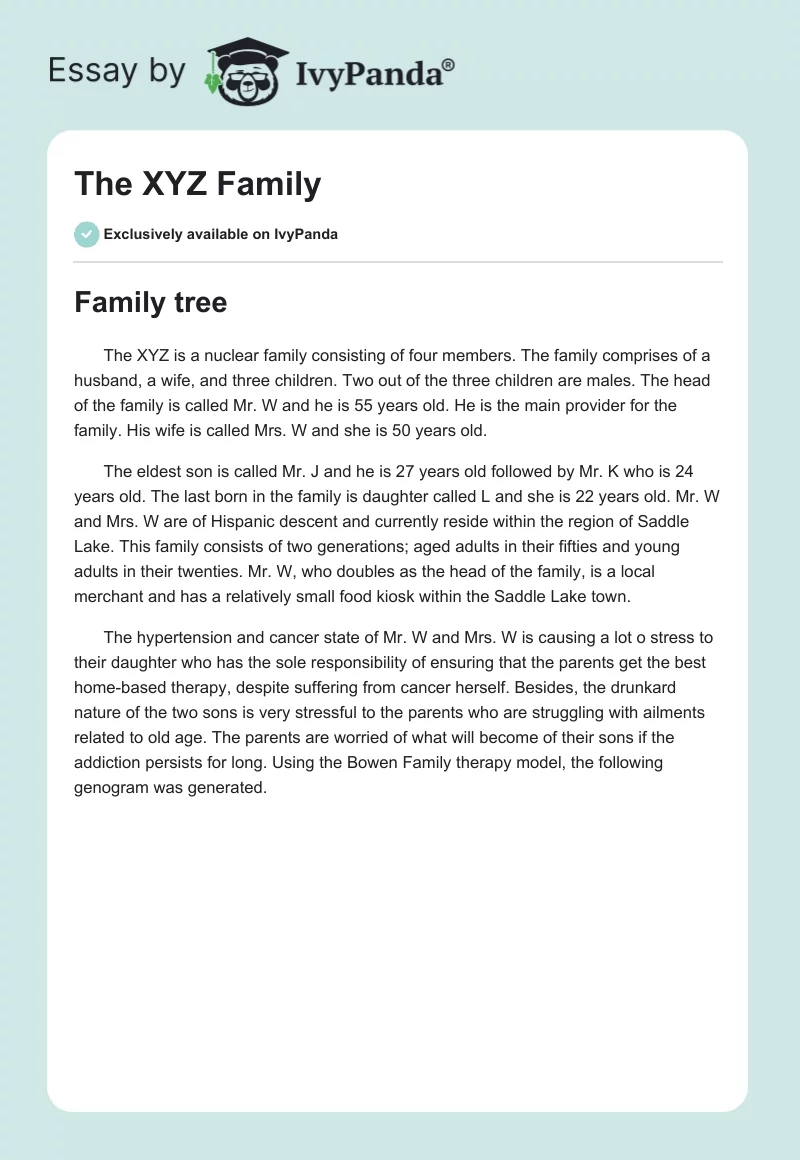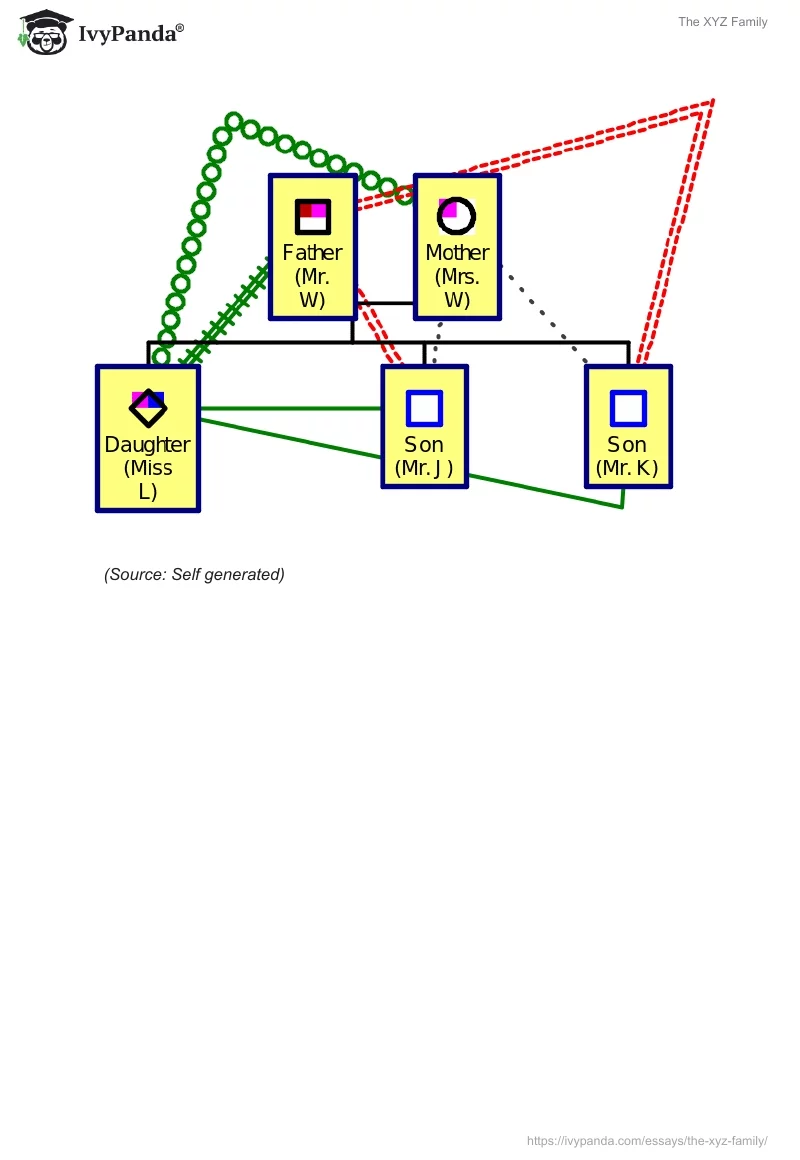Family tree
The XYZ is a nuclear family consisting of four members. The family comprises of a husband, a wife, and three children. Two out of the three children are males. The head of the family is called Mr. W and he is 55 years old. He is the main provider for the family. His wife is called Mrs. W and she is 50 years old.
The eldest son is called Mr. J and he is 27 years old followed by Mr. K who is 24 years old. The last born in the family is daughter called L and she is 22 years old. Mr. W and Mrs. W are of Hispanic descent and currently reside within the region of Saddle Lake. This family consists of two generations; aged adults in their fifties and young adults in their twenties. Mr. W, who doubles as the head of the family, is a local merchant and has a relatively small food kiosk within the Saddle Lake town.
The hypertension and cancer state of Mr. W and Mrs. W is causing a lot o stress to their daughter who has the sole responsibility of ensuring that the parents get the best home-based therapy, despite suffering from cancer herself. Besides, the drunkard nature of the two sons is very stressful to the parents who are struggling with ailments related to old age. The parents are worried of what will become of their sons if the addiction persists for long. Using the Bowen Family therapy model, the following genogram was generated.
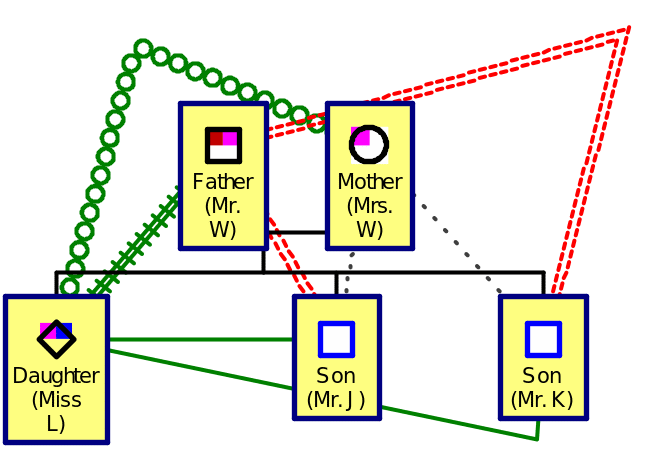
(Source: Self generated)
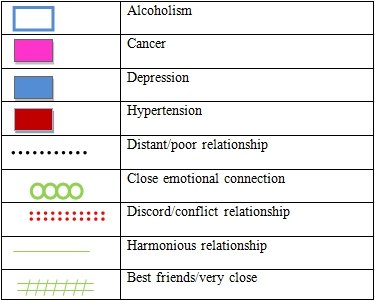
Social, economic, and environmental variables in the family
The family lives in a small rural house within the Saddle neighborhood. The house is not a modern shelter indicating that the family is not financially stable. As revealed by Mr. W, his annual income is $12,000, while that of his children is around $3,000 on average.
Since all members of the family are adults, each is allocated an age-appropriate role and has been successful in accomplishing these tasks. For instance, Mr. W and Mrs. W have managed to buy a house and train their children to highs school level of education. The children have currently taken up jobs at kiosk as part of serving interests of the XYZ family.
Stress management and health concerns
The family is in adulthood development stage since all the children are now adults. The parents are united in marriage and have raised another generation of adults, who are almost transitioning to their own marriages. The family has been successful in introducing Mrs. W as member of the family through marriage in the previous stage. From the union of Mr. W and Mrs. W, it has led to formation of three more members.
From the assessment, Mrs. W confessed that her father also had cancer condition when he was aged. This condition was also present in her grandfather who died of the ailment at the age of 50 years. Therefore, it is apparent that there is a family history of genetic predisposition to cancer disease from the family chain of Mrs. W. The condition has been there for the last three generations. Currently, it is a serious health concern in the life of Mrs. W, Mr. W, and their daughter.
Besides, the hypertension and cancer state of Mr. W and Mrs. W is causing a lot o stress to their daughter who has the sole responsibility of ensuring that the parents get the best home-based therapy, despite suffering from cancer herself. The drunkard nature of the two sons is very stressful to the parents who are struggling with ailments related to old age. The parents are worried of what will become of their sons if the addiction persists for long.
Theoretical model, intervention, and diagnosis
Theoretical model
In analyzing health concerns of this family, the intervention and diagnosis was done through the DSM-5 model. This model “allows clinicians and organizations more flexibility in how to organize diagnostic information” (Akin et al. 2012, p. 34). This means that clinicians are in a position to present the diagnostic information in an organized and presentable manner. This health promotion model is critical in facilitating achievement of high and desirable levels of well-being.
In relation to interventional plan for reducing cancer, the health promotion model has elements which directly encourage positive resource provision among the health care personnel. The underlying goals are assisting the patients change behavior as part for fighting colorectal cancer and offering alternatives, which patients may exploit to pursue ideal health.
This model operates on the assumptions that patients are proactive in controlling their own behavior and working to effectively improve the wellness and general environment. The DSM-5 has the diagnostic reliability scale for measuring the degree of accuracy in the tests and symptoms when carrying out diagnosis for a disease.
Besides, the intraclass kappa component is basically the scale for measuring the reliability of different raters for measurements to determine the consistency and absolute agreement with the predetermined scale (Jones-Smith, 2011).
In relation to the XYZ family’s health concerns on cancer and hypertension, the diagnosis involved classifying the type of illness a patient is suffering from through use of the predetermined diagnostic information that had a range of effect, that is, from mild to acute. The diagnosis was followed by tests that were measured against predetermined results for each state of the disease to ensure that it had good reliability as indicated in the DSM-5 model.
The clinical benefit of having a very good reliability was to guarantee accurate diagnosis and prober recording of the diagnosis information (Akin et al. 2012). The DSM-5 model dwelt on three main building blocks. These building blocks are preventive care, home based care, and treatment based care.
Through these elements, the intervention nurse was given an opportunity to implement the triangular intervention mechanism. The elements of counseling home based care and integrated community based support played a key role in success measurement. Output of the program was measured by the level of positive response as indicted in the diagram below (Akin et al. 2012).

(Source: Rigazio-DiGilio, 2005)
As indicated in the Watson’s theory of human caring, the XYZ family community has both normative and comparative needs. For instance, each individual in the community assessment group has unique medical and psychological needs which are not accommodated by the health and social support centers within the community.
In fact, direct nursing intervention as proposed by the change theory will ensure that the normative and comparative needs are addressed in a sustainable manner within the acceptable ethics of nursing (Lewis, 2011).
Diagnosis
From the assessment, it is apparent that the XYZ family is in dire need for counseling support, medical support, and social support in order to cope up with hypertension, cancer, and alcohol addiction. The two parents are suffering from cancer and hypertension while the sons are alcohol addicts.
The only daughter is also having cancer and it is taking a toll on the family. Since the XYZ family consists of members from two age groups, family structure and roles affect the family’s health in that the children have to cope with pressure of taking care of their ailing parents, despite having own health concerns. The children cannot afford health care for their parents and must take the role of nurses in the home-base care.
Framework for handling the therapy needs
Flow chart: Accreditation guideline
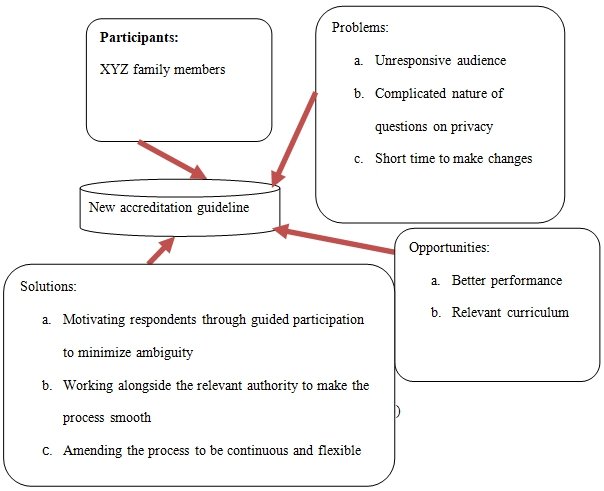
(Source: Rigazio-DiGilio, 2005)
Questions to ask
- What are your beliefs on complete wellness?
- Are there any ailments you are suffering from?
- What is the economic position of the family?
- Do you need any therapy support and are you willing to enroll in a therapy program?
- What would you recommend to help you manage the current health concerns?
Intervention
Medical support: Apparently, the members of the assessment community lack medical support despite existence of several health care centers within the assessment region. The health care centers do not have programs to support those without health care insurance. The senior members of the XYZ family community have to survive without proper medical attention.
The children of the family community also do not have medical insurance or guarantee from the local medical centers. There is need to establish a social trust for providing medical services to the poor at subsidized costs within the average income of households in the community (Akin, Mendi, Ozturk, Cinper, & Durna, 2012).
Counseling support: From the above community assessment, it is apparent that the social and youth service centers do not have the capacity to offer counseling services to the family community. The lack of capacity has made the health care accessibility a challenge within the assessment community.
The center should introduce stronger programs and structures within the youth, aged, and social centers to offer counseling services to the community in the form of emotional, and psychological counseling. This will go a long way in emotional needs for those suffering from different medical concerns (Akin et al. 2012).
Social support: The current structures within the local community health structures of the assessment family community do not have support services for emotional and physical assistance. The community does not have a strong community volunteers program to facilitate the needs of the XYZ family community. Therefore, there is need to establish a volunteer program to offer emotional and physical support to the LJH family community (Akin et al. 2012).
Objectives for implementing the intervention strategies
The objectives of this approach are sensitization of the XYZ family members towards preventive care, provision of free check up on a quarterly basis, and fast tracking the results of treatment through a voluntary follow up for treating patients as part of the cognitive therapy.
Expected outcome timeline
Within the 12 months period, the intervention nurse will cover the preventive and treatment for the XYZ family as shown in the catalogue below.
Outcome evaluation
Evaluation of the outcome will encompass process evaluation, impact evaluation, and outcome evaluation of the preventive health care strategy for addressing the three health concerns within the XYZ family. Process evaluation will examine actual implementation and development within a specific program. In this case, success of evaluation will depend on response rate to the strategies adopted to address the three ailments.
Specifically, the success will rely on the number of persons embracing the preventive community based health care strategy after the 12th month mark. Reflectively, it will review quantifiable fulfillment of targets of the program. Though done at the end of this program, it will evaluate all aspects from commencement to completion.
On the other hand, impact evaluation will examine long term changes that will surface as part of the success or failure of the intervention. It will examine the long term effectiveness of policy based programs after implementation. Outcome evaluation will examine the degree of change that has been witnessed due to successful implementation of the intervention (Akin et al. 2012).
Reflection
As a therapist, I need to be aware of my own ethic, gender, and cultural heritage in order to successfully execute the proposed therapy. As the community becomes increasingly diverse in the sense that it has become broader, the word ‘culture’ is used because it implies the integrated pattern of human behavior that includes language, beliefs and values. Understanding the values and beliefs of individuals are important for therapists.
I need to be aware of my negative and positive reaction to the values and tradition of the clients. Indeed, this attitude will be a great contribution to the counseling session since the XYZ family fall in the category of the high vulnerability (Casey & Wallis, 2011).
My beliefs that religion and meditation give people a framework within which to deal with the limitations in life will also be a contribution and something I will think about using in therapy in the XYZ family, especially in promoting holistic management of hypertension through minimizing stressful environment and healthy lifestyle.
I will be able to evaluate my values and goals as influenced by the family XYZ family genogram. For instance, the need to think about others and support each other will improve my sense of self awareness, when promoting inclusivity as part of the therapy.
As a family therapist, I should be aware of my cultural and ethnic heritage to ensure that the beliefs and values of every individual in the family are accommodated. Besides, I should be aware of my positive and negative perceptions toward heritage and values of clients as represented by diversity within the XYZ family genogram.
Besides, my understanding of religion and other stress relief strategies by relating to the XYZ family tree is necessary towards facilitating crisis management with the clients. Since the ultimate success of family therapy is dependent on how different counseling techniques are applied, I will recognize different views and perspectives to improve on the understanding of clients, their behave, and view of different aspects of life, which are the basic tenets of best practices in clinical therapy work (Ivey, D’Andrea, & Bradford, 2011).
Conclusion
From the above assessment, it is apparent that the XYZ family members are suffering from different ailments such as alcoholism, hypertension, and cancer. Through proactive home-based holistic therapy, it is predicted that intervention strategy will be successful in managing the current ailments. Streamlining the intervention program will facilitate ecological and community based health assessment, which is ideal in providing complete therapy to the XYZ family.
References
Akin, S., Mendi, B., Ozturk, B., Cinper, C., & Durna, Z. (2012). Assessment of relationship between self-care and fatigue and loneliness in haemodialysis patients. Journal of Clinical Nursing, 23(5-6), 856–864.
Casey, A., & Wallis, A. (2011). Effective communication: principle of nursing practice. Nursing Standard, 25(32), 35-37.
Ivey, A., D’Andrea, M., & Bradford, M. (2011). Theories of counseling and psychotherapy: A multicultural perspective: A multicultural perspective. New York, NY: SAGE Publications.
Jones-Smith, E. (2011). Theories of counseling and psychotherapy: An integrative approach: an integrative approach. New York, NY: SAGE Publications.
Lewis L. M. (2011). Medication adherence and spiritual perspectives among African American older women with hypertension. Journal of Gerontological Nursing, 37(6), 34-41.
Rigazio-DiGilio, S. (2005). Community Genograms: Using individual, family, and cultural narratives with clients. New York, NY: Teachers College Press.

